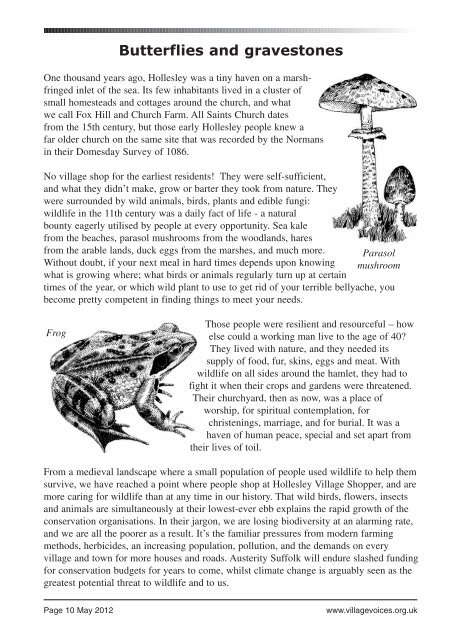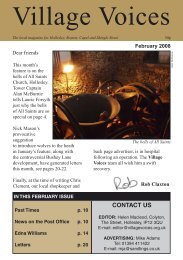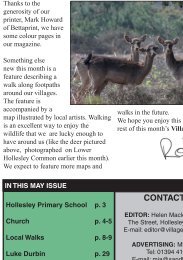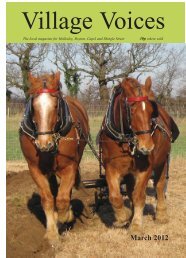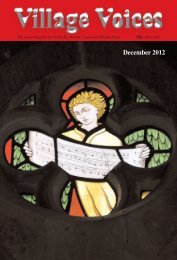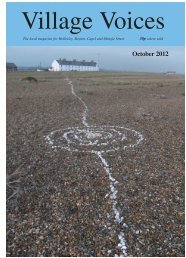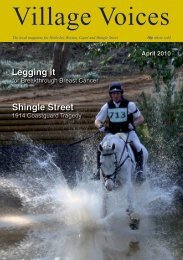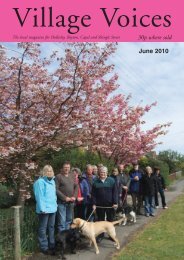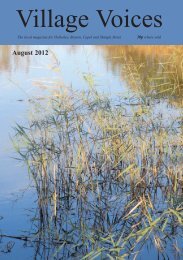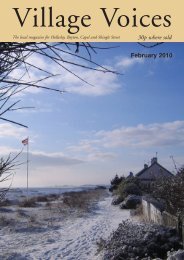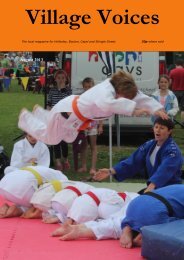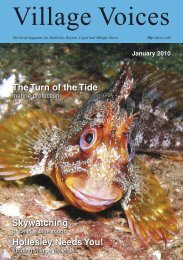May 2012 - Village Voices
May 2012 - Village Voices
May 2012 - Village Voices
You also want an ePaper? Increase the reach of your titles
YUMPU automatically turns print PDFs into web optimized ePapers that Google loves.
Butterflies and gravestones<br />
One thousand years ago, Hollesley was a tiny haven on a marshfringed<br />
inlet of the sea. Its few inhabitants lived in a cluster of<br />
small homesteads and cottages around the church, and what<br />
we call Fox Hill and Church Farm. All Saints Church dates<br />
from the 15th century, but those early Hollesley people knew a<br />
far older church on the same site that was recorded by the Normans<br />
in their Domesday Survey of 1086.<br />
No village shop for the earliest residents! They were self-sufficient,<br />
and what they didn’t make, grow or barter they took from nature. They<br />
were surrounded by wild animals, birds, plants and edible fungi:<br />
wildlife in the 11th century was a daily fact of life - a natural<br />
bounty eagerly utilised by people at every opportunity. Sea kale<br />
from the beaches, parasol mushrooms from the woodlands, hares<br />
from the arable lands, duck eggs from the marshes, and much more.<br />
Without doubt, if your next meal in hard times depends upon knowing<br />
what is growing where; what birds or animals regularly turn up at certain<br />
Parasol<br />
mushroom<br />
times of the year, or which wild plant to use to get rid of your terrible bellyache, you<br />
become pretty competent in finding things to meet your needs.<br />
Frog<br />
Those people were resilient and resourceful – how<br />
else could a working man live to the age of 40?<br />
They lived with nature, and they needed its<br />
supply of food, fur, skins, eggs and meat. With<br />
wildlife on all sides around the hamlet, they had to<br />
fight it when their crops and gardens were threatened.<br />
Their churchyard, then as now, was a place of<br />
worship, for spiritual contemplation, for<br />
christenings, marriage, and for burial. It was a<br />
haven of human peace, special and set apart from<br />
their lives of toil.<br />
From a medieval landscape where a small population of people used wildlife to help them<br />
survive, we have reached a point where people shop at Hollesley <strong>Village</strong> Shopper, and are<br />
more caring for wildlife than at any time in our history. That wild birds, flowers, insects<br />
and animals are simultaneously at their lowest-ever ebb explains the rapid growth of the<br />
conservation organisations. In their jargon, we are losing biodiversity at an alarming rate,<br />
and we are all the poorer as a result. It’s the familiar pressures from modern farming<br />
methods, herbicides, an increasing population, pollution, and the demands on every<br />
village and town for more houses and roads. Austerity Suffolk will endure slashed funding<br />
for conservation budgets for years to come, whilst climate change is arguably seen as the<br />
greatest potential threat to wildlife and to us.<br />
Page 10 <strong>May</strong> <strong>2012</strong><br />
www.villagevoices.org.uk


